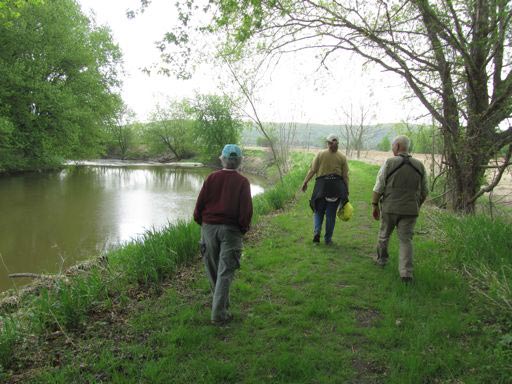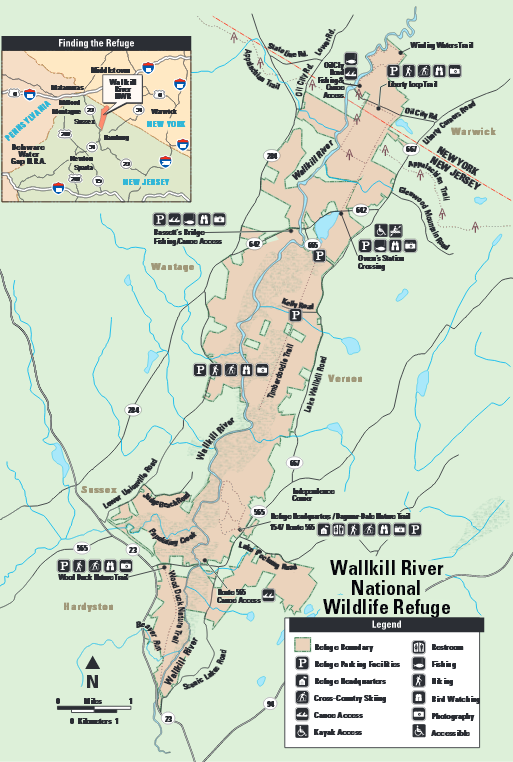Wallkill River National Wildlife Refuge borders the Wallkill River through Sussex and Vernon, New Jersey and into Pine Island, New York.
The Headquarters is located at 1547 County Route 565 (Glenwood Road), Sussex, New Jersey 07461. From Route 23 in Sussex, follow Route 565 north approximately 1.5 miles. Driveway will be on the left. The former farmhouse is used as an office. People are welcome to stop in weekdays for information on the refuge.
For more detailed directions, view the refuge website http://www.fws.gov/refuge/Wallkill_River/visit/directions.html.
Things to Do
The refuge offers many ways for people to enjoy the outdoors. There are several access points for hiking trails, canoeing or kayaking on the river, nature observation, fishing, and hunting. The refuge offers an ideal location for anyone interested in bird watching, botany, nature study, photography, and more.
Programs offered to the public are conducted at various points in the refuge including the headquarters, Owens Station Crossing, and the marked trails.
Owens Station Crossing is a 3-season public access area. The area and buildings are closed during the winter months. The office building located at 136 Owens Station Road, Sussex houses the Friends Nature Shop. The lake at this site is open for catch and release fishing and boating (no gas powered engines allowed).
Directions to Owens Station Crossing from Refuge Headquarters: Head northeast on County Road 565 for 1 mile. Turn left on Lake Wallkill Road and continue 3.5 miles to stop sign. Make sharp left onto Owens Station Road. Continue 1/2 mile to driveway on the left.
Nature Trails
There are currently five marked nature trails on the refuge, each one of which provides excellent wildlife viewing opportunities.
Route 565, Sussex
This beautiful trail, appropriately named for the secretive duck that calls the refuge home, was made possible through the hard work and dedication of refuge volunteers. This easy-walking trail now extends approximately 1.5 miles on a former railroad bed ending at the Wallkill River. Frogs inhabit the spring pools, turtles can be seen basking on logs, and other wildlife that frequent the wetlands can be found along the trail.

Oil City Road, Pine Island
Starting alongside the Wallkill River, this trail continues 2.1 miles northward in the New York section of the refuge. It offers views of the river, fields, and the woods.
There is a parking area at the start of the trail on Oil City Road.
Oil City Road, Pine Island
The 2.5-mile loop was created on a former sod farm, which, before it was manipulated for agricultural use, had been a forested wetland. The trail is co-aligned with the Appalachian Trail for one mile. The trail loops around several managed wetland units, providing an excellent opportunity to observe a wide variety of waterbirds, (ducks, geese, shorebirds and wading birds), as well as numerous species of songbirds along the edges of the trail in spring, summer and fall. In winter it attracts hawks and owls.
Refuge Headquarters
The trail travels through grasslands and hardwood forests from the Refuge headquarters down to the Wallkill River. The trail is 2.7 miles in length and consists of two loops. The North Loop (Blue Trail) is 1.7 miles in length and the South Loop (Yellow Trail) is 1 mile in length; both loops traverse hilly terrain. The trail gives views of the surrounding area. It is home to a variety of mammals, birds, arthropods, amphibians, and reptiles.
Bassett’s Bridge Road, Sussex
The trail, named for a bird that nests in the area, opened to the public on September 26, 2010. The 2.3-mile trail starts at Bassett’s Bridge Road and crosses Kelly Road, with parking areas on both roads. The nature trail is self-guided and passes through a variety of woodland, field and wetland habitats. In the spring, frogs call from the waters nearby and birds stake out nesting habitat.
